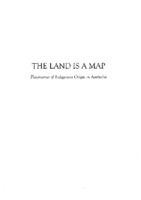The Land is a Map
Placenames of Indigenous Origin in Australia
| dc.contributor.editor | Hercus, Luise | |
| dc.contributor.editor | Hodges, Flavia | |
| dc.contributor.editor | Simpson, Jane | |
| dc.date.accessioned | 2013-11-12 00:00:00 | |
| dc.date.accessioned | 2020-04-01T14:54:07Z | |
| dc.date.available | 2020-04-01T14:54:07Z | |
| dc.date.issued | 2009 | |
| dc.identifier | 459353 | |
| dc.identifier | OCN: 310915572 | en_US |
| dc.identifier.uri | http://library.oapen.org/handle/20.500.12657/33699 | |
| dc.description.abstract | The entire Australian continent was once covered with networks of Indigenous placenames. These names often evoke important information about features of the environment and their place in Indigenous systems of knowledge. On the other hand, placenames assigned by European settlers and officials are largely arbitrary, except for occasional descriptive labels such as ‘river, lake, mountain’. They typically commemorate people, or unrelated places in the Northern hemisphere. In areas where Indigenous societies remain relatively intact, thousands of Indigenous placenames are used, but have no official recognition. Little is known about principles of forming and bestowing Indigenous placenames. Still less is known about any variation in principles of placename bestowal found in different Indigenous groups. While many Indigenous placenames have been taken into the official placename system, they are often given to different features from those to which they originally applied. In the process, they have been cut off from any understanding of their original meanings. Attempts are now being made to ensure that additions of Indigenous placenames to the system of official placenames more accurately reflect the traditions they come from. The eighteen chapters in this book range across all of these issues. The contributors (linguistics, historians and anthropologists) bring a wide range of different experiences, both academic and practical, to their contributions. The book promises to be a standard reference work on Indigenous placenames in Australia for many years to come. | |
| dc.language | English | |
| dc.subject.classification | thema EDItEUR::J Society and Social Sciences::JH Sociology and anthropology::JHM Anthropology | en_US |
| dc.subject.other | australia | |
| dc.subject.other | aboriginal australian | |
| dc.subject.other | geographical | |
| dc.subject.other | names | |
| dc.subject.other | Indigenous Australians | |
| dc.subject.other | Ngalakgan language | |
| dc.subject.other | Ngiyambaa language | |
| dc.title | The Land is a Map | |
| dc.title.alternative | Placenames of Indigenous Origin in Australia | |
| dc.type | book | |
| oapen.identifier.doi | 10.26530/OAPEN_459353 | |
| oapen.relation.isPublishedBy | ddc8cc3f-dd57-40ef-b8d5-06f839686b71 | |
| oapen.relation.isbn | 9781921536571 | |
| oapen.pages | 304 | |
| oapen.place.publication | Canberra | |
| oapen.remark.public | Relevant Wikipedia pages: Indigenous Australians - https://en.wikipedia.org/wiki/Indigenous_Australians; Ngalakgan language - https://en.wikipedia.org/wiki/Ngalakgan_language; Ngiyambaa language - https://en.wikipedia.org/wiki/Ngiyambaa_language | |
| oapen.identifier.ocn | 310915572 |

